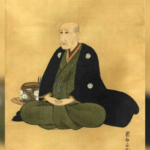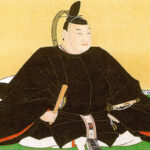

宮本武蔵 MIYAMOTO Musashi
1584? – 1645
Name List of Musashi
(Japanese historical figures change their names frequently.)
Bensuke→ Bennosuke or Takezo→ Shinmen Musashi no Kami Fujiwara no Harunobu→ Miyamoto Musashi
The Legend of Dual Wielding Sword Divinity
What samurai does the question, “who is the best known and the most famous swordsman in Japanese history?” remind you of? – The answer may be Miyamoto Musashi. He might have had more than 60 fights, but never lost, and seen as a genius swordsman. You can say that he is the most favorite swordsman of many katana fans since there are a lot of books, TV dramas, movies, etc. featuring Musashi. Notorious is the fight at Ganryu-jima, against Sasaki Kojiro. The icon of Miyamoto Musashi is the dual-wielding style which means fighting with two swords. He devised his own strategy “Niten Ichi-ryu (二天一流)” later in his life.
Early Life
The most credible theory is that Miyamoto Musashi (or Shinmen Musashi no Kami Fujiwara no Harunobu) was born around 1584 into a samurai family in Miyamoto village in Harima country according to what he introduces himself in “Gorin no sho (五輪の書)”. His childhood name was Bennosuke or Takezo, but it’s not verified which one is correct. He took his last name from his birthplace.
His father, Shinmen Munisai, was an expert swordsman skilled at both kenjutsu (technique of the sword) and jittejutsu (technique of self defence weapon used by samurai officers); he taught his son Musashi both of them. Munisai might have been very strict with Musashi. Musashi showed his talent for kenjutsu at a young age already.
Musashi’s mother died soon after he was born. He was raised by his step-mother Toshiko. His father got divorced later from Toshiko, and sent Musashi to his uncle Dorin, a monk from the Shoreian temple who taught his nephew Zen Buddhism and reading and writing. It is said that Munisai was killed during a fight against a samurai Ganryu Yoshitaka.
His Dueling Life
According to The Book of the Five Rings, Musashi started his career as a fighter when he was only 13 years old and killed a man in a single fight against a samurai from the Tajima Province, named Arima Kibei. Kibei was a swordsman from the Shinto-Ryu Kenjutsu school. Musashi threw Arima on the ground and hit him with his bokuto (a wooden sword, also known as a bokken). Arima Kibei died vomiting blood. At the age of 16, he defeated a very accomplished warrior Tadashima Akiyama.
Since Musashi’s family was allied to the Toyotomi clan, he fought for Toyotomi Hideyoshi at the Battle of Sekigahara in 1600. He participated in the attack on Fushimi Castle and in the defense of the besieged Gifu Castle in Gifu Prefecture.
In 1603, he fought against Tokugawa Ieyasu, and after the battle, Musashi left the temple and started to wander across the country to improve his sword skills and kenjutsu technique, have many duels, meet many sword masters, and also achieve his ambition to become the greatest swordsman in Japan.
In 1604, when Musashi was 21 years old, he defeated three duels against the members of the Yoshioka family and his name spread all over Japan. In the first two duels, he defeated the Kenpo brothers, Seijuro and Denshijiro. After them, he fought against a 13-year-old boy, Matashichiro who is Seijuro’s son. Matashichiro was helped by all students of the school, so Musashi had 60 opponents at the same time, but still, he defeated all of them. It’s said that Musashi discovered the superiority of wielding two swords during these battles. Using two swords simultaneously was very unusual since traditionally, samurai only fought with a long sword held in both hands. This was the beginning of the legend of Miyamoto Musashi.
The Duel at Ganryujima
Musashi’s most famous duel is in 1612, against his rival Sasaki Kojiro, the Ganryu School founder and a famous skilled samurai. It is said that Kojiro fought many duels against Japan’s best and never lost. The duel between the two skilled unbeaten swordsmen took place at the Ganryujima Island. Musashi was transported to the island on a boat by a local fisherman, as depicted by the very famous scene from many movies and TV-dramas. He arrived late for the duel as his strategy to disturb his opponent’s inner state. The fight was very quick and intense. Musashi was armed with a wooden sword and provoked Kojiro to make the first attack. But he countered quickly, breaking Kojiro’s left ribs and puncturing his lungs, killing him. After this duel, Musashi felt that he reached his peak as a swordsman, so he retired from the fighting life.
The Latter Half of Life
In 1614 and 1615, Musashi participated in both the winter and summer battles in Osaka which erupted between the Toyotomi clan and the Tokugawa families. It’s unclear who he fought for. Later the same year, Musashi took a role as a construction supervisor for the service of Ogasawara Tadanao from Harima Province. Musashi helped in the construction of Akashi Castle and helped to organize the layout of Himeji town. During this time, he was occasionally forced to fight, and he defeated all opponents. He also taught martial arts, kenjutsu, and shuriken, and he perfected his Enmei-ryu kenjutsu style. During this period of service, he also adopted a son named Mikinosuke who became a vassal to the Himeji fief.
Musashi wandered across Japan again, and in Edo in 1623 wanting to become a kenjutsu teacher for the shogun. However, it was not accepted so he started to travel again as a ronin. He left Edo and went to Yamagata City, and adopted his second son, Iori. He established a kenjutsu school, however, it’s unknown where it was in Japan. Musashi trained some students and helped to suppress the Shimabara Rebellion in 1637.
Musashi took the position as a retainer of Hosokawa Tadatoshi who was a Lord of Kumamoto in 1640. Two years later, he suffered from neuralgia attacks, and felt that death is near. Next year, he retired to a cave named Reigando to write his “Gorin no sho” and finished it in 1645, giving it to his student. He wrote “Hyoho Sanjugokajo
(兵法三十五箇条)” and “Dokkodo (獨行道)”, too. In his later years, Musashi was also a cultural person. He liked calligraphy and ink painting, and made sword equipment such as Menuki (hilt ornaments). He died in Reigando cave on June 13, 1645.
Kamon (Family Crest)
Miyamoto Musashi’s family crest is “Kuyo Tomoe (九曜巴)” which is designed from a combination of stars and comma-shaped magatama. “Kuyo” originated from the ancient Indian astrology that was worshiped as “Kuyo Mandala” in Japan. Eight small circles (=stars) are arranged around a large circle just like stars traveling around a celestial body, symbolizing faith. This symbol was perfect for samurai who were revered as gods of war and used as family crests. Kuyo Tomoe is the family crest of Uesugi Kenshin’s father, Nagao Tamekage, and so as Miyamoto Musashi.
.
.
.




